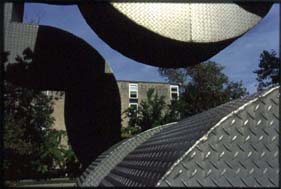 Requiem
for a residence hall
Requiem
for a residence hall
Few
alumni are sorry to see the demise of Woodward Court, but-oh,
the memories.
If
it were possible to cast away the gloom of the Woodward Court
basement, the glow from Liz Hurtig's face on Saturday, October
20, would have done it.

"Let's
see. I seem to remember the time clock being somewhere around
here," she murmured, peering at a dark wall. "Yes!
Here! Where this electrical panel is! And the matron's desk
was over there." Hurtig, AB'64, AM'67, beamed at the small
group of alumni touring the residence hall after the "Remembering
Woodward" breakfast in residence masters Ted and Lee Cook's
suite. Nell Smith, AB'85, shot Hurtig a slightly horrified-but
clearly intrigued-look, as Hurtig explained that the 11 o'clock
curfew (midnight for upperclasswomen) and segregation of the
sexes were strictly enforced during her student days. The mostly
middle-aged group smiled back, shaking their heads at the memory
of punch cards and a matron holding sway over a College coed's
social life.
This
was the first time since packing up their diplomas that any
of the group had been back inside the residence hall that tens
of thousands of students loved to hate, with its bleak basement
corridors and sweaty cinder-block walls, small and frigid (or
parching) rooms, and vertically ricocheting acoustics. It was
also their last chance to visit Woodward-where many say they
forged their deepest friendships-before its demolition next
summer to make room for a new business-school complex.
At
breakfast a group of about 20 former Woodward residents living
in Chicago gathered to swap tales of the stuff of dorm life:
sex, drugs, social triumphs and turmoil.
In
1960 Hurtig, a 16-year-old from Baltimore, moved into what was
then called New Dorms, a modern four-story U-shaped complex
designed by Eero Saarinen and constructed in 1957-58. For the
dorm's first half-decade 500 undergraduate and graduate men
and women were squeezed into East, North, and West Houses. By
the mid-1960s the dorm had been renamed Woodward, and the overcrowding
was eased to 330 students living in what had become Wallace,
Rickert, and Flint Houses (later split into Upper and Lower
houses, with Harper House added in the 1990s).
"1960
was very different from 1964," Hurtig said. "Birth
control was not readily available until my senior year, and
the fear of pregnancy was great. The fishbowl [lobby] was where
people made out. You could have a guy in the room, but he had
to have one foot on the floor-people would come to check. But
it wasn't something we questioned."
Nor,
said Hurtig, did anyone question the room-keeping rules: each
Friday, women marched dirty linens to the basement and collected
clean sheets, while men's beds were made by housekeepers. ("Why
would we question it? Guys were too stupid to make their own
beds," quipped one alumna.)
When
Dan Hayman, AB'71, MAT'73, made his home in Woodward Court,
it was transitioning toward coed living, and times had changed
in other ways. "Woodward Court was known in those years
as the Pharmaceutical Society," he joked, and several guffaws
went up across the room. Hayman and others also recalled vividly
the South Side riots after the assassination of Martin Luther
King Jr. "I remember watching out my window as the Blackstone
Rangers [street gang] were surrounded by the National Guard
on the Midway," he said.
Ann
Morris, AB'75, AM'81, described the striking view from her room:
Robie House. (That hardly made the dorm livable for fourth-floor
residents such as Leslie Recht, AB'70, who noted that the coldest
place in her room was the radiator: "So that's where I
kept cheese.")
Not
a few in the group felt vindicated to learn that the man who
had assigned them to the cursed dorm had lived there himself-Ed
Turkington, recently retired dean of student services and a
New Dorms resident in 1958-59, grinned at the stories. Still,
he must have done something right: Zaverie Moore, AB'88, and
Laura Bader, AB'88, announced they've been best friends since
sharing a Wallace House room.
When
Woodward's current residents migrate this winter to the orange-brick
Max Palevsky Residential Commons on 56th Street-Wallace, Flint,
and Rickert Houses intact and Harper rechristened Woodward-the
friendships (and traditions like the Wirszup Lectures) will
migrate with them.
In
anticipation of the impending move, Wallace residents painted
the old cinder-block halls orange this fall. But after 35 years
of hard living, Woodward looks nothing like its early-1960s
glory days. No matter: Liz Hurtig still knew her room number
by heart.
-S.A.S.

![]()
 Requiem
for a residence hall
Requiem
for a residence hall